U.S. Department of Transportation
Federal Highway Administration
1200 New Jersey Avenue, SE
Washington, DC 20590
202-366-4000
Federal Highway Administration Research and Technology
Coordinating, Developing, and Delivering Highway Transportation Innovations
|
LTPP News This newsletter is an archived publication and may contain dated technical, contact, and link information. |
|
| Publication Number: FHWA-HRT-16-074 Date: January-June 2016 |
Publication Number:
FHWA-HRT-16-074
Issue No: Vol. 11 No. 1 Date: January-June 2016 |
| Email Distribution List |
|
| Contact |
Customer Service
|
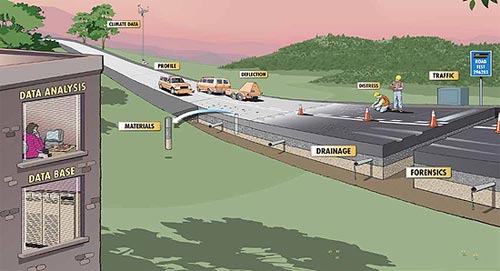
|
LTPP Newsletter |
The Federal Highway Administration’s (FHWA) Office of Infrastructure Research and Development has completed a comprehensive book called, The Long-Term Pavement Performance Program, which documents the history and future direction of the Long-Term Pavement Performance (LTPP) program. Subdivided into three parts, the 306-page book touches on every aspect of the LTPP program and includes hundreds of references. Part I discusses building and managing the program and includes a special section dedicated to past and current program managers. Part II describes the development of experiments and the database. Part III highlights products developed, lessons learned, and the future direction of the program.
More than a written account of the program, the LTPP book serves as a testament to the commitment, dedication, and partnership of many people and organizations involved with the program for over 20 years. Support from State and Provincial highway agencies, the American Association of State Highway and Transportation Officials (AASHTO), Transportation Research Board (TRB), industry, and academia has been invaluable for the LTPP program. FHWA appreciates this support and how it continues to make the LTPP program a success.
This success is a result of collaborative teamwork from everyone involved in the program—past and present. This team-spirit approach helped document the program’s rich history and future direction. The lead authors of the various chapters of the book were selected based on their expertise and knowledge of the different parts of the program. They were tasked with writing down everything they knew about a particular part of the program. The chapters were edited later as needed. The lead authors are Aramis López (LTPP Team Leader), Gary Elkins (LTPP Technical Support Services Contractor), Mark Gardner (formerly with the LTPP Southern Regional Support Contractor), the late Frank Meyer (LTPP North Atlantic and North Central Regional Support Contractors), Gonzalo Rada (LTPP Technical Support Services Contractor), and Kevin Senn (LTPP Western Regional Support Contractor).
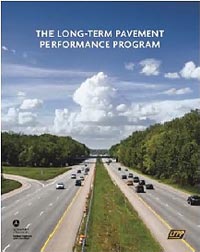 Front cover of the book, The Long- Term Pavement Performance Program. |
There were also many other contributing authors and reviewers that verified the accuracy and completeness of each chapter. In the beginning, the LTPP program office created a small working group to develop a first draft of the book’s outline. The group consisted of Charlie Churilla and Paul Teng, former LTPP program managers, Judith Corley-Lay, from the North Carolina Department of Transportation (DOT) and Michael Murphy, formerly with Texas DOT. Corley-Lay and Murphy actively served on the TRB Expert Task Group on LTPP Data Analysis.
LTPP program staff and contractors, members from the program’s Expert Task Group on LTPP Special Activities, the LTPP Committee, and TRB staff reviewed contents of the book for accuracy and completeness as the work progressed. Many also provided images for the book. Aramis López, Jonathan Groeger (LTPP Technical Support Services Contractor), and Susan Yoder (Editor) served as final proofreaders and reviewers under the leadership and direction of Deborah Walker (LTPP Team Member).
The LTPP program wishes to thank its partners for helping to answer the question: How and why do pavements perform as they do? We hope you enjoy taking a walk down memory lane and reading about the LTPP program’s exciting path forward.
If you did not receive a copy of the book and would like to, contact LTPP’s Customer Support Service Center at ltppinfo@dot.gov or 202-493-3035.
An increased focus on geotechnical performance management inspired FHWA’s Geotechnical Research Program to partner with the LTPP team to quantify the bump at the beginning and end of various bridge sites. These bumps are not just an annoyance to the traveling public; the dynamic impact of vehicles moving over the bump can cause distress, fatigue, and long-term deterioration of the bridge deck. The bump can also cause damage to vehicles and potentially create an unsafe condition for drivers if the issue is not mitigated in a timely manner.
To ensure the bump is within tolerable limits based on safety, ride ability, and effects to long-term bridge performance, transportation agencies need a tool that can quickly assess the bridge approach transition. The inertial profilers used by the LTPP program were employed to assess this transition.
Inertial profilers are systems mounted to the front of a vehicle that are equipped with laser height sensors and corresponding accelerometers to collect data, compute the longitudinal profile along each wheel path, and determine the roughness of the road surface (see photo). Longitudinal distance is measured using an instrument mounted to the rear wheel of the vehicle. Global Positioning System receivers are also located on the vehicle to map position. Using a data acquisition system, the vehicle is able to collect data at a speed of 50 miles per hour as it is driven along the road.
More information about inertial profilers can be found in the LTPP Manual for Profile Measurements and Processing. For a current version of the manual, contact LTPP Customer Support Service Center at ltppinfo@dot.gov or 202-493-3035.
Traditionally, inertial profilers have been used to track pavement assets. FHWA had not tested bridges using this technology. A pilot study was initiated to develop a draft protocol that outlines the procedures for measuring the profile of bridge approaches. The protocol was then tested at a few bridge sites. The results provide a road profile for different wheel paths in two different directions, with demarcations noted for bridge ends (see graph).
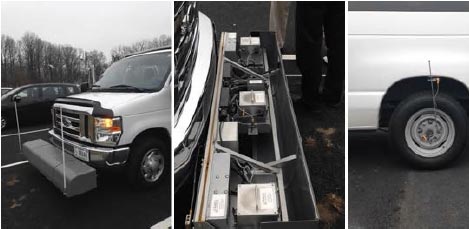 Inertial profilometer vehicle (left), sensor bar with cover open (center), and distance measurement instrument (right). |
By focusing on the bridge approaches from this site, the profiler can clearly distinguish the transition (see graph). Further data processing to correct for grade will allow engineers to quantify the bump at the end of the bridge. This quantification can be used in conjunction with other bridge performance data to better define tolerable service limits.
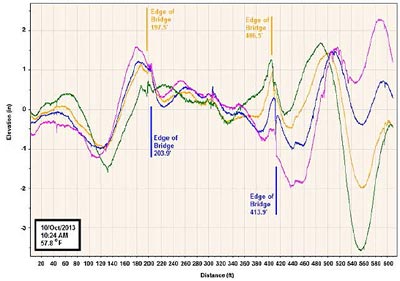 Measured bridge and approach profiles with bridge locations marked. |
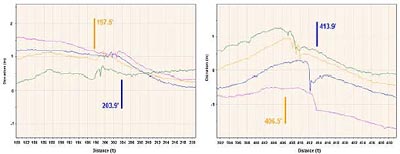 Bridge transition profiles with bridge end locations marked. |
Additional testing across a wide variety of bridges—including Every Day Counts Geosynthetic Reinforced Soil Integrated Bridge Systems and Long-Term Bridge Performance (LTBP) bridges—will help correlate the bump with long-term bridge performance and develop a performance measure based on the inertial profiler. The tool can then ultimately be used to further help transportation agencies manage and preserve their bridge inventory.
For more information, contact Jack Springer at jack.springer@dot.gov or (202) 493-3144, or Jennifer Nicks at jennifer.nicks@dot.gov or (202) 493-3075.

Launched in 2014, LTPP InfoPave™ enables users to easily tap into the wealth of pavement performance data and knowledge available through FHWA’s LTPP program. To be in compliance with the requirement that Government-owned Web portals have a .GOV Web address, the new official site for LTPP InfoPave™ is https://infopave.fhwa.dot.gov. The previous uniform resource locators (URLs), http://www.infopave.com and http://infopave.com, have been configured to automatically redirect users to the .GOV Web site. In addition to the new URL, security features have been enhanced by applying Secure Sockets Layer (HTTPS) technology, which creates a secure connection between the user and the server.
By using the latest in computer technology, this Web-centric interface is designed to improve access to LTPP data through user-friendly visualization features. In addition to the pavement performance data from more than 2,500 test sections, the interface provides information, education, and tools to maximize the use of available data. With LTPP InfoPave™, LTPP data is at your fingertips, allowing you to explore and extract the right data efficiently for analysis to advance the science of pavement engineering and management.
In January 2016, an enhanced version of LTPP InfoPave™ was released to the public at TRB’s annual meeting in Washington, D.C. For more information, contact Y. Jane Jiang at jane.jiang@dot.gov or (202)493-3149.
In 2015, the LTPP program initiated an academic community outreach activity by visiting over 25 universities throughout the country. This outreach is in conjunction with routine State visits. Initial outreach efforts indicated that both professors and students were eager to have Federal staff and contractors from the program visit the schools. They were pleased with the presentations and impressed with the LTPP program’s outreach efforts to engage the academic community.
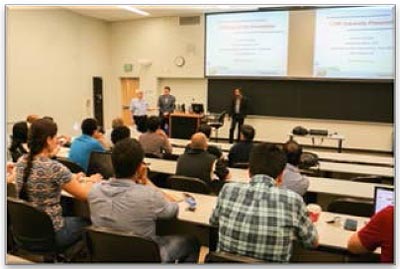 Students at Purdue University learn about the LTPP program. |
The primary purpose of this outreach effort is to disseminate information about the LTPP program to future engineers. This includes letting the audience know who we are, what we do, and how to harness the vast resources that are available through the program. The presentations include a brief overview of the benefits of the LTPP program; an introduction to the LTPP InfoPave™ Web site; current and future program activities; and potential academic uses of LTPP data and tools using sample applications and case studies. As the audience consists of faculty and students, an overview of the American Society of Civil Engineers (ASCE) and LTPP International Data Analysis Contest is also given to encourage participation.
This new outreach activity for the LTPP program has been well received. The program plans to continue this effort to keep academia engaged and further develop the LTPP program’s relationship with the institutions producing the next generation of engineers.
Each year at the TRB annual meeting, the LTPP program holds sessions to discuss program activities and present findings from analysis studies that are of interest to the pavement community.
The Data Analysis Working Group (DAWG) Forum on Pavement Performance Data Analysis (held January 9, 2016), consisted of 12 presentations, including 2 briefings of winning papers in the 2015 International Data Analysis Contest, managed by LTPP and the Transportation and Development Institute (T&DI) at ASCE.
The LTPP State Coordinators’ Meeting (held January 10, 2016) featured opening remarks from Michael Trentacoste, FHWA’s Associate Administrator for Research Development and Technology (RD&T), and Keith Platte, AASHTO’s Associate Program Director for Project Delivery. Both executives remarked that they are pleased that we now have a 5-year highway bill with the implementation of the Fixing America’s Surface Transportation (FAST) Act. They also encouraged highway agencies to get involved in using the vast amount of data and information available in LTPP InfoPave™. The LTPP program is a huge asset with a lot of data that should be used by States in addressing needs. Tom Baker, Chairman of the LTPP Committee, echoed the sentiment that it is important and necessary for States to become more involved in the program. While funding is an issue for the program going forward, work is still being done.
Key enhancements to LTPP InfoPave™ were highlighted. For example, WesTrack data is now a part of the non-LTPP hub on LTPP InfoPave™.
Warm-mix asphalt (WMA) overlay sites in New Mexico, Manitoba, Oklahoma, Oregon, Texas, and Washington have been constructed and the program is now beginning to monitor the long-term performance of the various mixes. There is still a need to acquire test sites in the wet-freeze area of the country.
Pavement preservation has been around for a long time. However, much of the decisionmaking processing makes use of “old” information. This new experiment will focus on the timing of a treatment and will monitor the performance of three treatment types for both flexible and rigid pavements. For flexible pavements, the treatments that will be monitored include:
For rigid pavements, the LTPP program will monitor the performance of the following preservation treatments:
The main objective of the pavement experiment is to determine the correct timing for the application of various treatments.
Scott Seiter, from the Oklahoma Department of Transportation, gave a very good presentation summarizing his State’s experience in building a new warm-mix asphalt overlay test section. The 4-mile test site located in central Oklahoma not only meets the requirement for the LTPP program, it also is being used for some additional research led by the State. Seiter challenged his State counterparts in the audience to "just do it" because it is worth it.
Dave Luhr and Tom Baker with the Washington State Department of Transportation also gave compelling presentations about the importance of States being actively involved in the LTPP program. Luhr talked about his State’s leadership with the SPS-2 pavement preservation pooled fund study, TPF-5(291), in which the LTPP program is an in-kind contributor. Baker then discussed the need to look at why LTPP test sections fail. The forensic investigation of the LTPP test sections pooled fund study, TPF-5(332), is also led by Washington State with FHWA, New York, and Texas as financial partners. Similar to the SPS-2 pavement preservation pooled fund study, Washington is also looking for more partners to join the effort in performing forensics on LTPP test sections as they leave the program.
In addition to the above presentations, there was a presentation that reported on preliminary findings from an ongoing LTPP data analysis study that is examining the influence of environment on pavement roughness using data collected at SPS-1 projects.
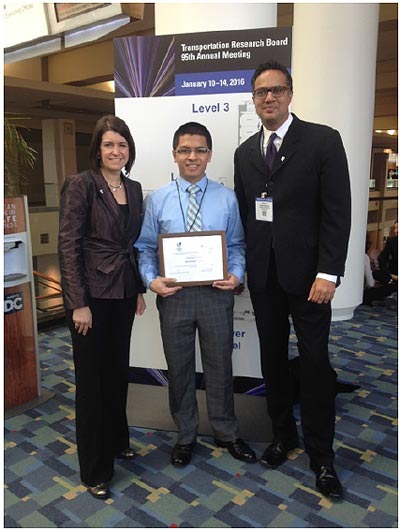 Lenor Bromberg (left), President, and Muhammad Amer (right), Director of Transportation & Development Institute of ASCE, with Ronell Joseph H. Eisma, first place graduate winner. |
Closing remarks at the coordinators’ meeting were given by LTPP Team Leader Aramis López. “The State of the LTPP program is good,” he said. While the program has had to operate on 36 short-term highway legislative extensions that have made managing it difficult, it is good to have a highway bill. There are some funding challenges to face, but the work of the program continues. It continues through the active participation of States and the commitment by FHWA to deliver products that agencies need. With the construction of six new warm-mix asphalt overlay sites scheduled this calendar year (two in Arizona and one in Florida, Missouri, Ontario, and Nevada), the development of the experimental design for the pavement preservation experiment, and improved tools for selecting performance grade (PG) binders and accurate weather data, the LTPP program is committed to developing tools pertinent to State needs.
Long-Term Pavement Performance: Pavement Preservation Experiment and Data Analysis Results was the theme of the LTPP Technical Session (held January 11, 2016). Gonzalo Rada presented an update on the “LTPP Pavement Preservation Experiment.” Gilbert Baladi presented results on “LTPP’s Study of Pavement Performance Measures and Forecasting, and the Effectiveness of Maintenance and Rehabilitation (M&R) Treatment Strategies.” Rohan Perera reported findings in the presentation, “LTPP Examines Influence of Environment on Pavement Roughness.” In addition, this year’s ASCE-LTPP data analysis contest winners presented their winning papers (see following section).
These topics drew a full room of attendees. A poster session on LTPP InfoPave™ was also held to allow one-on-one discussions with users.
For the past several years, ASCE and the LTPP program have been partners in the ASCE-LTPP International Data Analysis Contest. This year, both partners were pleased to receive very good papers from students, and were delighted to make a first place award in two of the four contest categories.
Student team members, Ronell Joseph H. Eisma and John Gondek, from Michigan State University, won first place in the graduate category for “Evaluation of the Effectiveness of Diamond Grinding Treatments Due to Site Factors and Profile Characteristics.” Xueqin Chen, a visiting student from China attending the University of Tennessee, won first place in the challenge category for “Development of Distress Condition Index Using the LTPP Data Through Structural Equation Modeling.”
The winners attended TRB’s annual meeting and presented their work at the DAWG meeting. For the first time, the students also presented their analysis results at the LTPP Technical Session. They were officially recognized at the LTPP State Coordinators’ meeting for their accomplishment.
The 2015-2016 contest ended June 1, 2016. Contest guidelines for next year are being developed and will be available at the beginning of the 2016-2017 academic year. To access these guidelines, please visit LTPP’s Web site in August.
Indepth determination of poor and good performing pavements.
Forensic investigations of LTPP test sections as they go out of service is a significant “value added” activity, as it is the only means of definitively determining or confirming the cause (or causes) of pavement deterioration (e.g., how much of the rutting measured at the surface occurs in each of the pavement layers). The TRB LTPP Committee has long advocated for an expanded pursuit of forensic investigations. FHWA concurs that the value of forensic investigations for LTPP test sections is important, but due to budgetary constraints it is not able to assume full responsibility for performing the investigations. In 2015, the Washington State DOT initiated the pooled fund study, “Performing Forensic Evaluations of LTPP Remaining Sections Before They Leave Service”, TPF-5(332), to carry out the additional data collection and analysis activities needed for forensic investigations.
FHWA has committed $80,000 to the forensic pooled fund study and the LTPP program will be available to assist State and Provincial highway agencies in conducting forensic studies at select LTPP test sites as their service life ends. FHWA supports and encourages other States to participate in the pooled fund study.
During the LTPP State Coordinators’ meeting, Michael Trentacoste announced the retirement of Aramis López, who has served as LTPP Team Leader since 2001.López will officially retire from FHWA on September 30, 2016.
Summary of Key Benefits 1989 - 2015
FHWA-HRT-16-013
January 2016 [PDF]
LTPP InfoPave
FHWA-HRT-16-027
January 2016 [PDF]
LTPP InfoPave Q&A
FHWA-HRT-16-028
January 2016 [PDF]
Long-Term Pavement Performance Program Determination of In-Place Elastic Layer Modulus: Backcalculation Methodology and Procedures
FHWA-HRT-15-036
December 2015 [PDF]
TechBrief: Determination of In-Place Elastic Layer Modulus: LTPP Backcalculation Methodology and Procedures
FHWA-HRT-15-037
August 2015 [PDF]
Report: https://www.fhwa.dot.gov/publications/research/infrastructure/pavements/ltpp/13090/index.cfm
FHWA-HRT-13-090
April 2016 [PDF]
Join us on Facebook and YouTube to find FHWA’s latest news, information, and resources...
HRDI-30/9-16(Web)E
FHWA-HRT-16-074